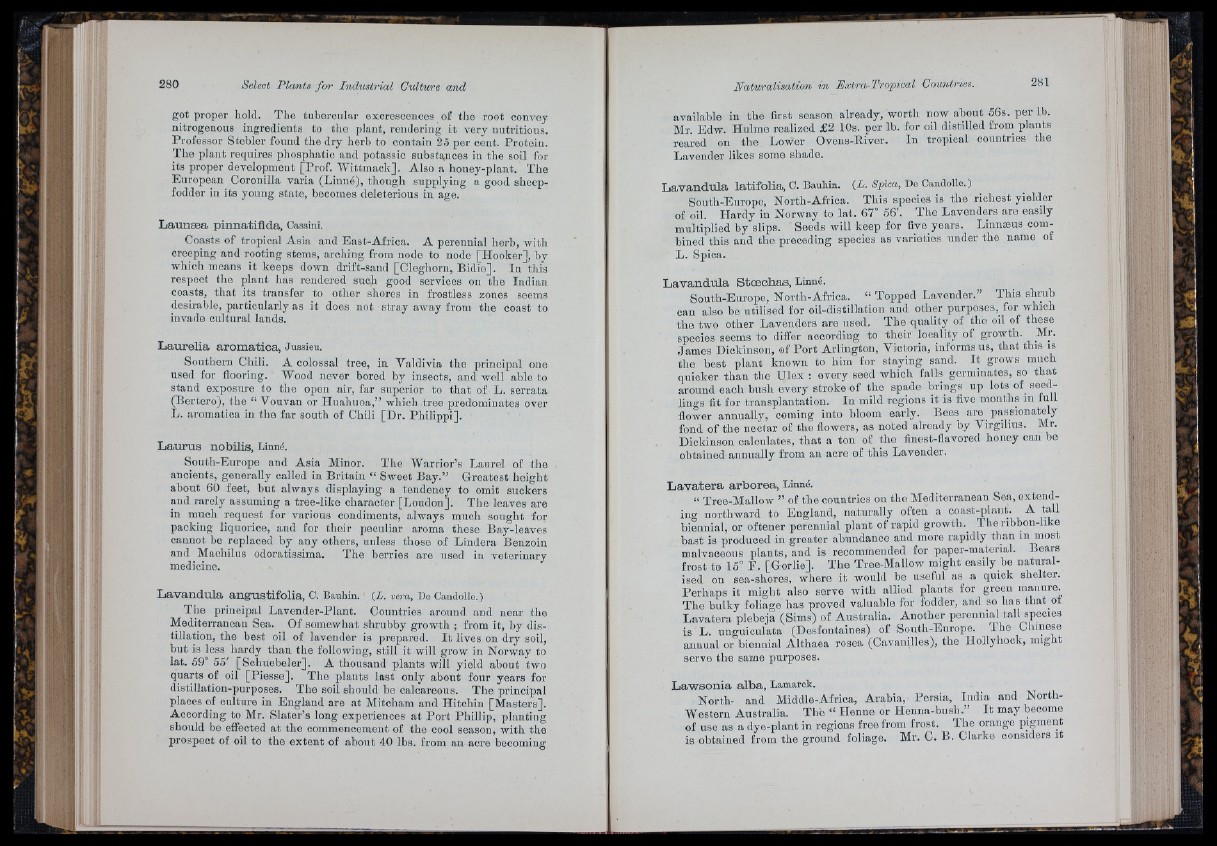
Jî 4
Select Plants fo r Industrial Culture and
got proper hold. The tubercular oxoresceiicos of tho root convoy
nitrogenous ingredients to tlio plant, rendering it very nutritious.
Professor Stobler found tlie dry herb to contain 25 per cent. Protein.
Tho plant requires phosphatie and potassic siibstanees iu tlie soil for
its proper development [Prof. Wittmack], Also a honey-plant. The
European Coronilla varia (Linné), tiiough supplying a good sheep-
fodder in its young state, becomes deleterious in ago.
Launæa pinnatiflda, Cassini.
Coasts of tropical Asia and East-Africa. A perennial herb, with
creeping and rooting stems, arcliing from node to node [Hooker], by
which moans it keeps down drift-sand [Cleghorn, Bidio]. In"'t]iis
respect the plant has rendered suoli good services on tlie Indian
coasts, tliat its transfer to other shores in frostless zones seems
desiralilo, particularly as it docs not stray away from the coast to
invade cultural lands.
Laurelia aromatica, Juaaieu.
Soutliern Chili. A colossal tree, in Valdivia tho principal one
used for flooring. Wood iiover borod by insects, and well able to
stand exposure to tlio open air, far superior to that of L. serrata
(Bertero), tho “ Vouvau or Hualiuoa,” wliteli troo predominates over
L. aromatica in tho far south of Cliili [Dr. Pliilippi],
Laurus nobilis, Linné.
South-Europe and Asia Minor. Tlie Warrior’s Laurel of the
ancients, generally called in Britain “ Sweet Bay.” Greatest lieight
about 60 feet, but always displaying a tendency to omit suckers
and rarely assuming a tree-like cliaractor [Loudon]. The leaves aro
in mncli request for various condiments, always much sought for
packing liquorice, and for tlioir peculiar aroma those Bay-leaves
cannot be replaced by any others, unless tlioso of Lindora Benzoin
and Machilus odoratissima. Tho berries are used in veterinary
medicine.
Lavandula angustifolia, C. Bauhin. ' (L. vera, De Candolle.)
The principal Lavender-Plant. Countries around and near tho
Mediterranean Sea. Of somewhat slirnliby growth ; from it, liy distillation,
tho best oil of lavender is prepared. I t lives on dry soil,
but is loss hardy tiian tho following, still it will grow in Norway to
iat. 59° 55' [Schuebeler]. A thousand plants will yield about two
quarts of oil [Piesse]. 'The plants last only about four years for
distillation-purposes. 'Tlie soil should bo calcareous. Tlie principal
places of oulturo in England are a t Mitcham and Hitchin [Masters],
According to Mr. Slater’s long exporiencos a t P o rt Phillip, planting
should bo effected at the commencement of tlie cool season, with the
prospect of oil to tho extent of about 40 lbs. from an acre becoming
m ' i
281
available in the first season already, worth now about 56s. per lb.
Mr. Edw. Hulme realized £2 10s. per lb. for oil distilled from_ plants
reared on tbo Lower Ovcns-Bivor. In tropical countries the
Lavender likes some shade.
Lavandula latifolia, C. Bauhin. ( i . Spica, Do Candolle.)
South-Europo, North-Africa. This species is tho richest yielder
of oil. Hardy in Norway to lat. 67° 66'. 'The Lavenders arc easily
multiplied by slips. Seeds will keep for five years. Linnæus combined
this and the preceding species as varieties under the name of
L. Spica.
Lavandula Stoechas, Linné.
Soutli-Europe, Nortli-Africa. “ Topped Lavender.” Tliis shrnb
can also bo utilised for oil-distillation and other purposes, for which
the two otlier Lavenders aro used. 'Tlio quality of tho oil of these
species seems to differ according to their locality of growth. Mr.
James Dickinson, of Port Arlington, Victoria, informs ns, that this is
the best plant known to liim for staying sand. I t grows much
quicker than tlio Ulox : every seed which falls germinates, so th a t
around eacli bnsh every stroke of tlio spade brings up lots of soed-
iings fit for transplantation. In mild regions it is five months in full
flower annually, coming into bloom early. Bees are passionately
fond of the nectar of the flowers, as noted already by Virgilius. Mr.
Dickinson calculates, th a t a ton of the fmost-flavorod lioiiey can be
obtained annually from an aero of this Lavender.
Lavatera arbórea, Linné.
“ 'Tree-Mallow ” of tho countries on tho Mediterranean Sea, extending
northward to England, naturally often a coast-plaiit. A tall
biennial, or oftener perennial plant of rapid growth.^ The ribboii-liko
bast is produced in greater abundance and moro rapidly tlian in most
malvaceons plants, and is recommended for papor-matorial. Boars
frost to 15° E. [Gorlie]. The 'Tree-Mallow might easily be naturalised
on sea-shores, where it would he useful as a quick sliolter.
Perhaps it miglit also serve witli allied plants for grcou maniiro
The bulky foliage has proved valuable for fodder, and so has th a t ot
Lavatera plobcja (Sims) of Australia. Another poreniiial tall species
is L. iinguicuiata (Desfontaines) of Soiith-Enropo. Tlie Clnnoso
annual or biennial Althaea rosea (Cavanilles), tlio Hollyliock, miglit
serve tho same purposes.
Lawsonia alba, Lamarck.
North- and Middle-Africa, Arabia, Persia, India and North-
Western Australia. 'Tlic “ Ilonno or Honna-biish.” I t may become
of use as a dyo-plant in regions free from frost. Tho orange pigment
is obtained from tho ground foliage. Mr. C. B. Clarke considers it
'J ^ ' 'I